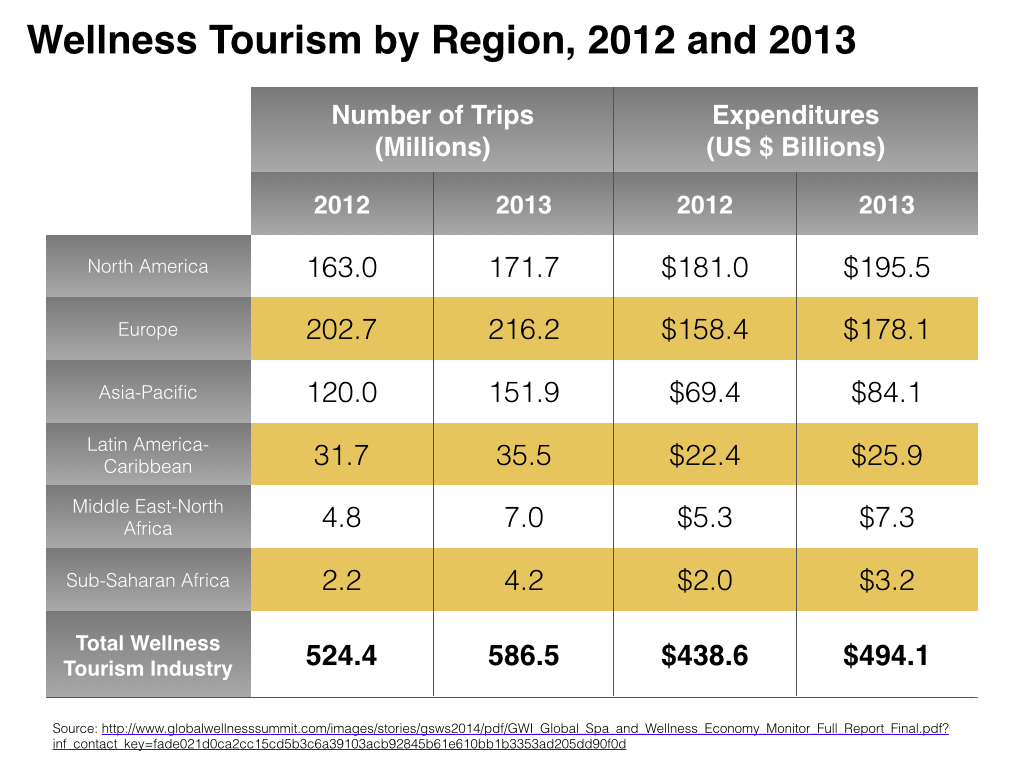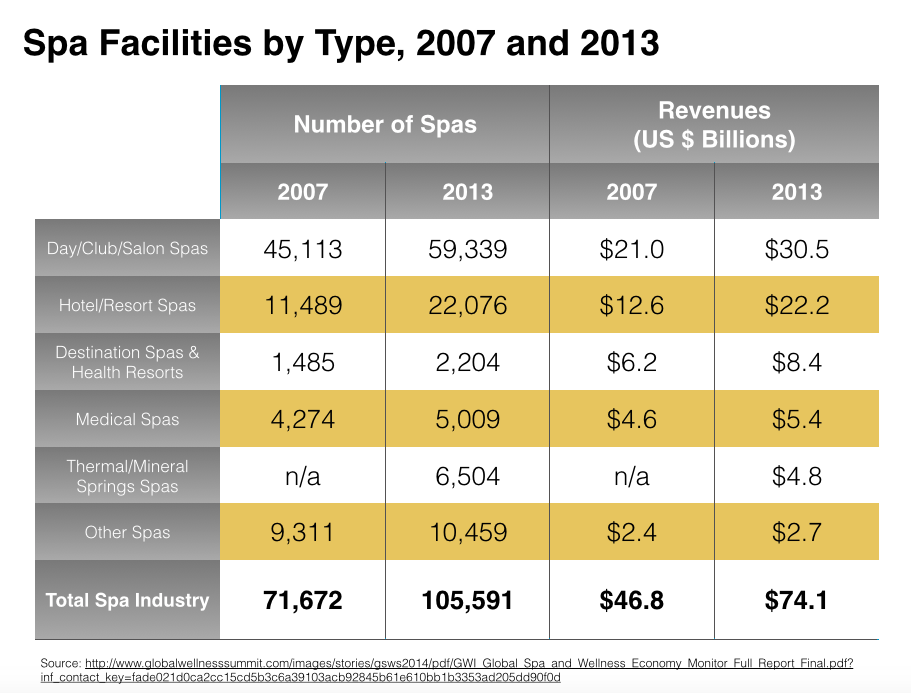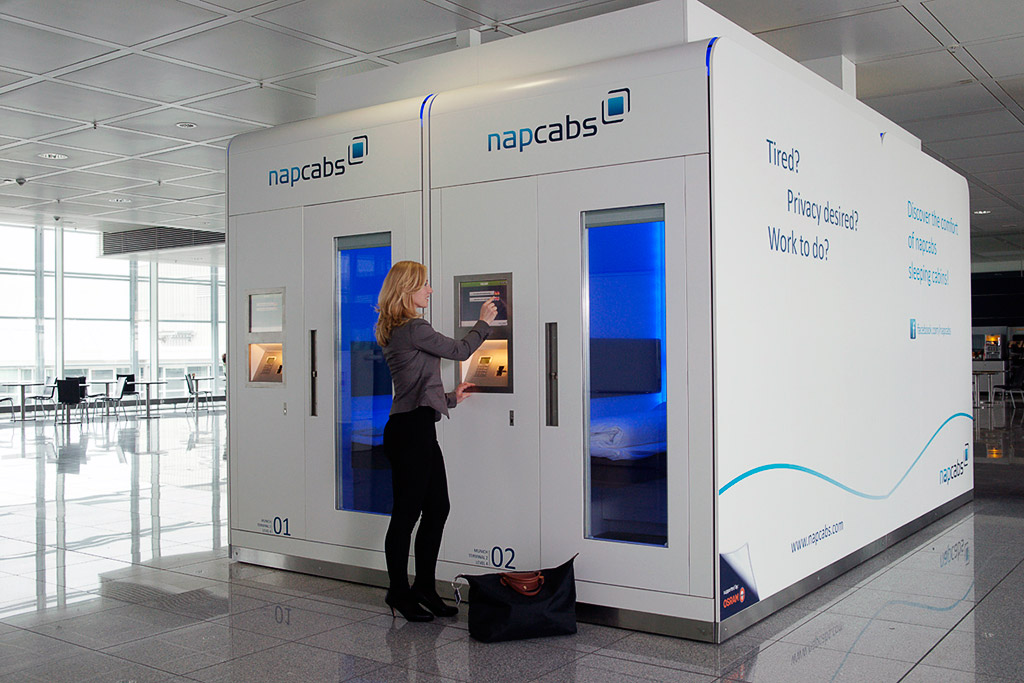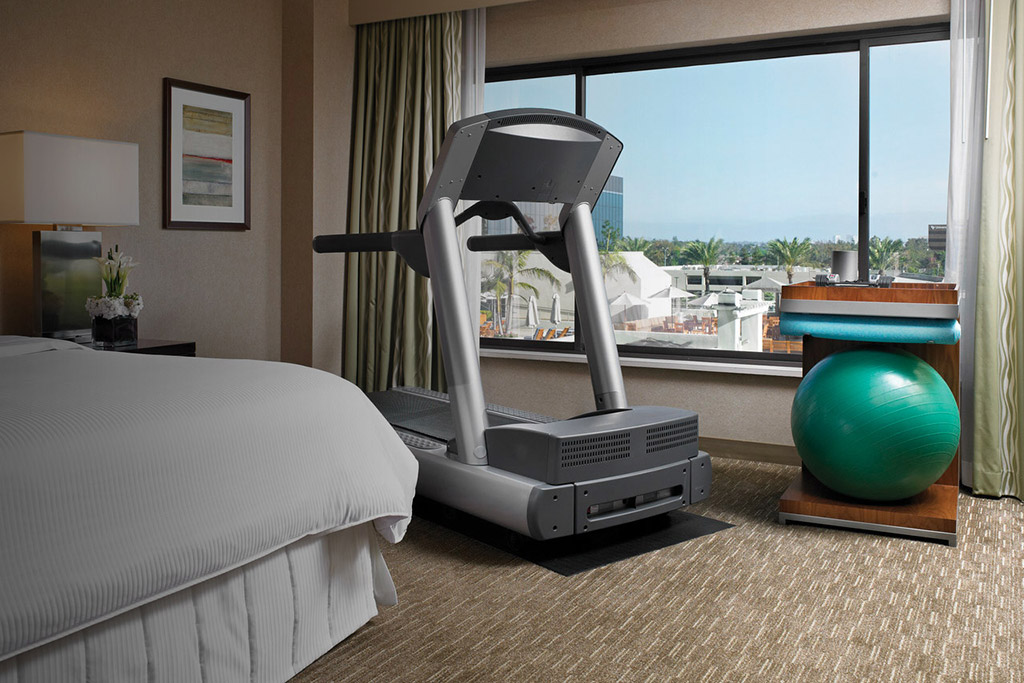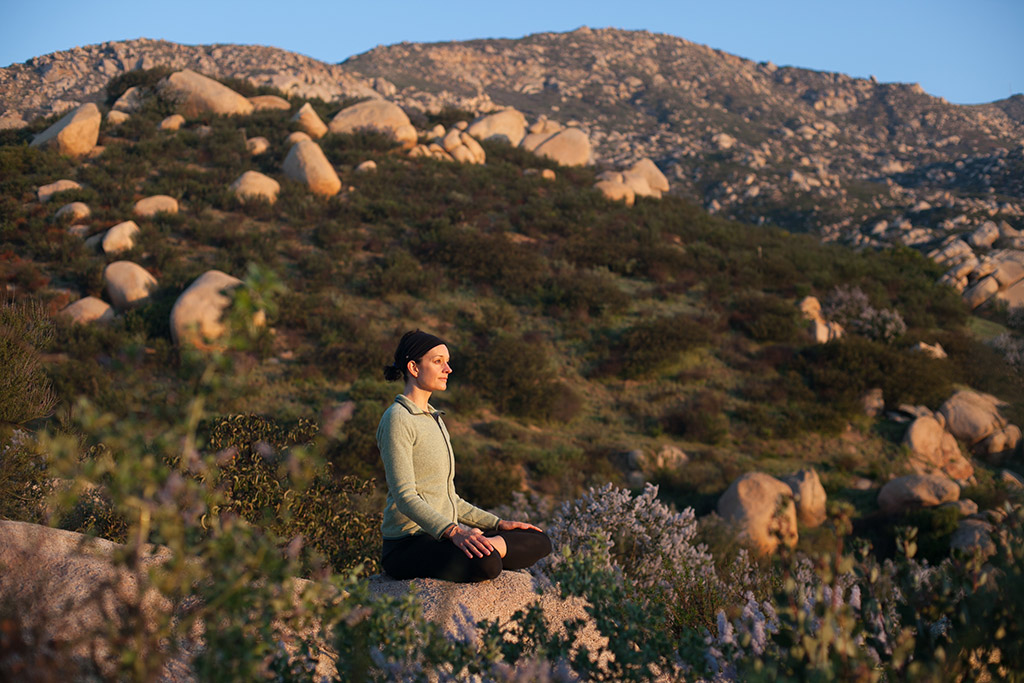Executive Summary
The question for travelers used to be: Business or Pleasure? Today, there’s a third answer: Wellness.
That’s because a growing number of folks that travel are seeking to integrate healthy eating, fitness and mind-body habits into their journeys, be it gluten-free dining options at airports to Vitamin C showers and yoga mat-outfitted hotel rooms. Even spa destinations known for health-focused programming are upping their game with amenities tailored specifically for busy executives and families. What’s more, a new travel segment focused exclusively on immersive Yoga travel developed around them.
In order to compete for the attention and dollars of these healthy-minded travelers, those in the tourism and hospitality industry need to understand the amenities they demand and deliver on them along every step of their journey.
Introduction
The days of savvy travelers being satisfied with a firm mattress, cozy bathrobes, sweet-smelling shampoo and conditioner, and a hearty breakfast?
That’s no longer going to do for some travelers.
Today, a growing number are focused on being healthy on the road—seeking special meals, in-room well-being amenities and entire trips planned around their preferred mode of fitness.
Take the Toronto’s Shangri-La Hotel. It partnered with LuLulemon to offer guests a 25-minute yoga sequence that can be viewed in-room on a TV or iPad, while London’s Corinthia Hotel offers guests a calming, pre-bedtime Sleep Ritual treatment.
These are examples of “Wellness Tourism,” or travel associated with the pursuit of maintaining or enhancing one’s personal well-being.1 It is made up of sectors including healthy eating, nutrition and weight loss; and fitness and mind-body pursuits. It’s a $494 billion industry, and growing, up 12.3% YoY, according to the Global Spa and Wellness Economy Monitor, released in September and conducted by SRI International.
The spa industry, categorized separately from Wellness, has grown 7.7% annually, from $60 billion in 2007 to $94 billion in 2013.
Spending among these travelers is robust. So-called “high-yield” tourists, these folks spent $1,639 per international trip in 2013, or 59% more than the average international tourist. Domestic wellness travelers spent $688 per trip, or 159% higher than the average domestic tourist.
What’s behind it? Some travelers look to these amenities to counteract negative impacts such as poor dietary choices, jet lag, and sleep disruption while on the road. A growing middle class is driving wellness tourism in emerging economies in Asia, the Middle East, Africa and Latin America. And as consumers of all ages (including adults who are taking more responsibility for their health and Millennials who grew up doing so) adopt more healthy habits at home, they look to incorporate this lifestyle while traveling.
The tourism industry is answering the call. Airports are installing amenities like yoga and stretching facilities, walking paths, more indoor green space and healthier dining options including seasonal, locally sources meals, and choices that cater to the growing vegan and organic audiences.
Like the Shangri-La and Corinthia, hotels are also upping their games, by offering guests yoga mats and running trail maps, and outfitting rooms with Vitamin C showers, air purification systems and wake-up light therapies. Celebrity fitness trainers are partnering with hotels to create in-room wellness content. At hotels worldwide, travelers can now find cold-pressed juices, vegetarian, gluten-free and even macrobiotic menus.
Some spas, not longer able to rely solely on massages and saunas to lure guests, are finding new ways to increase their footprints and menu of offerings.
The fitness industry is also contributing to the growth of Wellness Tourism, most notably in the yoga space, with festivals boasting classes, seminars, hiking, music and healthy, locally sourced meals. For those looking to explore a new culture while they Om, week-long trips, bring guests far and wide for daily yoga, sightseeing, shopping and socializing.
In order to capture this growing segment, those in the hospitality industry need to understand the amenities these travelers are demanding and how to successfully meet this need.
Staying fit and eating well at airports
Folks departing out of Dallas Fort Worth (DFW) and looking to relax before their flight can kick back over a glass of wine at any number of restaurants, recharge their devices at gateside docking stations or browse knickknacks before boarding their plane.
They can also head to a Yoga studio (at Gate 40) or walking path for a fitness break. No need to BYO Yoga mat; the free studio is equipped with them, and also provides hand sanitizer and a view of the tarmac. Terminal D’s walking path measures seven-tenths of a mile and features two optional step courses, or 55-foot staircases connecting Skylink mover stations.
DFW is not alone in its offering; Yoga rooms can be found at numerous airports, including San Francisco (SFO), Burlington, Vermont (BTV) and Albuquerque, NM (ABU), and walking paths are on offer at Louis Armstrong New Orleans Airport and Indianapolis International Airport. Travelers in and out of Phoenix can shed a few calories on a two-mile interior fitness trail.
Those looks for a cardio boost will find it at the Philadelphia International Airport, which has outfitted certain terminals with stationary bikes. They compliment a pop-up gym that circulates among the airport’s terminals every two weeks.
Mia Kyricos, Chief Brand Officer at Spafinder Wellness, calls this “spa en route.” In addition to fitness options, it includes healthy food choices, outdoor spaces, and health stations where one can check her blood pressure or Body Mass Index (BMI).
“There has been a lot going on at the airports in many different ways,” she says. “You first had the nail salons, then that was followed by chair massage. Now we are seeing nap rooms, and people can take a shower.”
Indeed, weary travelers waiting for their connections in Munich, Dubai and Delhi can rest up in so-called sleep pods; Munich’s “NapCabs” come equipped with a single bed, workstation, alarm clock, internet access and air conditioning. A multi-media touchscreen allows users to choose lighting options, and check flight times.
At Singapore’s Changi Airport, travelers can access open-air rooftop Cactus and Sunflower Gardens, with over 40 different species of cacti and succulents from Africa and the Americas. An Enchanted Gardens takes it up a notch; motion sensors trigger nature sounds while LED lighting along pathways sparkle as walkers stride by. Four giant flowering sculptures shimmer with stained glass, freshly cut flowers and ferns.
Kyricos says amenities like fitness stations and outdoor space are meant to offset the negative impact of travel on our bodies. Lower oxygen levels result in fatigue and a drop in mental alertness, and sitting in a cramped seat inhibits blood flow.
Eat well, be well
Then there’s the food. Ask any seasoned traveler and they will likely tell you they’d like to change what they find at airport restaurants and snack kiosks.
They’re in luck. A December report by the Physicians Committee for Responsible Medicine found that at 23 of the nation’s busiest airports, 75% of restaurants are now offering healthy meals.2 That’s an important revenue driver, since 55% of travelers buy food at the airport, according to a study by Go Airport Express.3
At Baltimore/Washington International Airport (BWI), Silver Diner offers a seasonal, locally sourced flexitarian menu of stir-fries with quinoa, a kidney bean chili and Fall Harvest Salad with 10 fruits and vegetables. Travelers will find numerous fresh salads at Ram’s Head, and at Zona Cocina and Chipotle, they can customize vegetable-packed salads, tacos, and burrito bowls.
Across the country, at Seattle/Tacoma International Airport (SEA), Kobo serves vegetable sushi, garden salads, and miso soup. Coffee drinkers can head to Starbucks for veggie and brown rice bowls with roasted butternut squash, beets, kale, and steamed broccoli with a lemon tahini dressing.
Healthy food options are also being phased in at airports across the globe. Travelers through Sydney can grab made-to-order greens at Sumo Salad and fruit juice and yogurt-based as well as dairy-free smoothies at Boost Juice Bar. And Hong Kong International Airport’s Café Deco serves various vegetarian meals like coconut-based curries, salads and soups.
Meet the healthier hotel
Guests at the Harbour House Hotel on Salt Spring Island in British Columbia enjoy rooms with outdoor fireplaces, water views and jetted baths for two.
Also on the menu? A restaurant serving ultra-fresh farm-to-table fare including 70 varieties of fruits, herbs and vegetables, 100% grass-fed beef and ethically fished and harvested seafood.
It’s indicative of a growing trend among hotels—to provide meaningful wellness amenities and experiences beyond the occasional in-room massage or round the clock fitness room. And with travel and tourism growing – arrivals reached a record 1.1 billion in 2013, up 5.1%, according to the World Travel Market Global Trends Report4, it’s imperative for those in the hospitality industry to adopt meaningful wellness amenities to stay competitive.
“Hotels are pulling out all the stops,” says Linden Schaffer, Founder, Pravassa Wellness Travel. “They’re offering on-site group fitness classes on their roofs or gardens, and many more in-room options for fitness where it’s a yoga mat, pilates ball, or iPad programming where you can watch free fitness videos. Many luxe and boutique hotels are adding organic and local ingredients to their menus and even offering healthy snacks in the mini-bar.”
Healthy food choices thrive
Take Elsa, the restaurant at the Monte Carlo Beach Hotel. It recently received a Michelin star for its 100% organic fare, which includes Pumpkin Cream Soup, Wild Sea Bass with Seasonal Citrus and Roasted Suckling Pig with Caramelized Shallots and New Potatoes.
Others are tweaking their offerings on a less-grand scale. Kimpton Hotels now serves fresh-pressed juices at its U.S. properties, and at the Ace Hotel Downtown Los Angeles houses a juice bar featuring mixes from Moon Juice, which are also stocked in the hotel’s mini bars. At the Chicago Marriot O’Hare, guests on the go can avail themselves of salads, Greek yogurt and berries and antibiotic-free Lemon Pepper Chicken from a vending machine, aptly named the “Farmers Fridge.”
Like Monte Carlo’s Elsa, hotel restaurants Stateside are also getting makeovers. The Farmer’s Market restaurant at the Wyndham Boca Raton serves grass-fed beef, free-range chicken and sustainable seafood as well as vegetarian, vegan and gluten-free menu items. Westin Hotels now offer kid-tested healthy meals in a partnership with SuperChefs. And the Cork and Kale platform at Even Hotels, a new brand from Intercontinental Hotel Group, features SPE-certified menu items, or food that is sources, prepared and enhanced according to the organizations’ nutritional specifications. This includes heart-healthy, low-fat, paleo and vegetarian dishes, and a “Good to Go” service in which guests order their breakfast the night before, then pick it up in the morning on their way out.
Staying fit on the road
Even Hotels stands out not only for its food program, but for its holistic approach to wellness. Launched in June, it features a front-and-center gym just off the lobby, a “flex room” for Spinning and Yoga, and rooms with ergonomic furniture, back-supporting headboards, natural eucalyptus linens and specified fitness zones equipped with a balance ball, yoga mat and exercise equipment.
Indeed, busy guests now expect to be able to work out beyond the gym, and other savvy hotels are helping them do that.
Members of Fairmont’s loyalty club have access to Reebok sneakers and exercise wear, and Trump Hotels now provide “fit kits” complete with iPods and UnderArmour sneakers and clothing. Westin is the model here; its running program, RunWestin, has for years loaned guests New Balance gear and provided running concierges at select properties to lead scenic runs in each area.
Hotels are even partnering with leaders in the fitness industry to offer guests specialized fitness experiences. W Hotels’ FIT with Tara Stiles, instructor and owner of Strala Yoga, features an in-room workout video and accompanying tip cards. At select locations, guests can buy a package of classes with Stiles herself. And Manhattan’s soon-to-be-reopened Knickerbocker Hotel has announced former Knick Larry Johnson as its “fitness curator,” to select equipment for the hotel’s two gyms, and collaborate on wellness amenities.
At New York City’s Refinery Hotel, guests can take rooftop Spinning classes, while the Hotel La Jolla has partnered with Barre 3, a nearby studio with Ballet/Pilates classes.
“In the last year, the industry has gotten much more substantive as to the different types of programming its offering,” says Kyricos. “What’s driving it is the industry has finally caught up with the consumer. We have a much more health conscious consumer now that we have to cater to.”
Mind-body perks on the rise
But health goes beyond breaking a sweat, which is why some hotels are focused on creating an overall sense of well-being by focusing on mind-body amenities.
Take the MGM Grand. The hotel’s “Stay Well” rooms feature showers with Vitamin C-infused water, air purification, light therapy to reduce the effects of jet lag and mattresses made without harmful VOCs or toxic chemicals and off-gases. 1 Hotels, an eco-luxury brand, provides guests with in-room meditation videos, while Westin takes its wellness programming beyond fitness with podcasts including “Switching Off From Work” and “Getting Ready For Sleep.”
And it should come as no surprise that in a world where one can download music and movies at the touch of an app, and have any number of goods delivered to their door in 24 hours, that wellness amenities are now being made available the moment a guest walks through the door.
Oberoi Hotels and Resorts keep its spas open 24/7, while Cheval Blank Randheli in the Maldives offers guests a 20-minute Jet Lag Recovery massage upon check-in. Masseuses at Maya Sayang in Bali, soothe weary feet with a welcome foot massage.
For business travelers, especially, who may not yet be loyal to one brand of hotel, and need this type of service before an early-morning meeting, say, this helps create connection and loyalty, says Kyricos.
Healthy destinations
Spas and providers of wellness retreats have long been at the forefront of Wellness Tourism, with yearly demand growing since the Global Wellness Institute started monitoring it in 2007.
But some are finding increasingly sophisticated travelers are looking for more than
reflexology, fat-free meals and afternoon hikes. To remain competitive, many are expanding their services to target a new audience seeking health and wellness programs.
“It’s all about the wellness package now,” says Schaffer. “Spas have realized that most people are not just booking stays to ‘detox.’ Instead they are looking at total body health.”
Evolution of the spa trip
Carlsbad, California-based Vera Via’s recently launched Executive Health Reboot aims to not only de-stress busy C-Suite types, but get them thinking about and maintaining their wellness long after they leave. A typical week-long stay focuses on fitness education, including ways to minimize risk of exercise-related injury, stay fit while traveling and work out better in less time. Proper eating habits are tackled, including strategies for maintaining healthy choices while traveling and dining out, and prioritizing nutrition in a busy schedule. Participants are also immersed in wellness measures like stress-management.
Of course, this is a luxury health and fitness retreat with a price tag just shy of $10,000, which means high-end accommodations and healthy food that doesn’t taste like cardboard.
Canyon Ranch, in Lenox, Mass.; Rancho La Puerta, in Tecate, Mexico; and Pritikin in Miami have followed suit, offering programs at busy and often unhealthy executives.
Rancho La Puerta is also targeting families with the typical classes and spa treatments for adults plus specialized amenities for kids, including less-challenging hikes, healthy cooking classes, and art projects. There are family water classes, and at dinnertime kids can choice from a host of options like whole-wheat pizza and gluten-free pasta.
“We’ve been doing it now for two to three years, but this is the year we are really seeing more interest in booking,” says Roma Maxwell, Director of Public Relations. “I think that for our guests in particular they had always considered the Ranch to be a place for adults and it took them time to understand they can bring kids.”
Other spas are focusing on modernizing their grounds, rooms and common areas in a bid to keep up with its glossier competitors.
Last year, the 57-year-old Golden Door in San Marcos, California, underwent a massive renovation, upgrading its rooms, lobby and doubling its size to 600 acres, resulting in more hiking areas, and revamped its agricultural areas to focus on holistic, organic fare. That’s likely to better compete with global destinations like the coastal spa at Mukul Beach, Nicaragua. An example of the 100% immersive experience guests are demanding, it provides them a completely private spa experience from three hours to full day. Six separate spa buildings are connected and themed, among them, a Healing Hut, Crystal Temple and Rain Forest.
Yoga takes center stage
There is a demand for Yoga-centric getaways where guests can focus on honing their practice among like minded travelers in oftentimes exotic vacations.
It makes sense. Twenty million Americans practice some form of Yoga, according to Yoga Journal,5, up 29% from the previous 2008 study. What’s more, they spend $10.3 billion a year on yoga classes and products, including equipment, clothing, vacations, and media.
Erica Gragg and partner Francesco Anchisi, started Escape To Shape in 2007, creating two to three bespoke trips per year with an emphasis on daily Yoga practice, immersion into and exploration of the local culture and healthy dining for two dozen guests per trip. Their business has grown to 12-15 weekly trips a year, costing upward of $6,000, in such places like Cambodia, Cartagena, Sri Lanka, Vietnam, Marrakech, Sicily and Ecuador. Gragg and Anchisi continue to hone their offerings as demand grows.
“Our program has expanded to include wellness and fitness activities beyond Yoga,” she says. “We are now offering boot camp classes that incorporate using nature as our gym in unique backdrops around the world — from the temples of Angkor Wat to the ramparts of Cartagena. We have collaborated with the internationally acclaimed barre-based workout and fitness favorite, Physique 57 and are now offering multiple Physique 57 Escapes in various locations around the world.”
On the other side of the spectrum are so-called Yoga Festivals, often three- to four-day long gatherings featuring hourly classes, seminars, hiking, music and healthy, locally sourced meals. Wanderlust caters to thousands of guests at a time in 10 locations, including San Francisco, Aspen-Snowmass, Phoenix and Stratton, VT, offering a long weekend’s worth of Yoga, meditation, lectures and music (past performers include Moby and Common) and has expanded to include the Wanderlust 108, a day-long event featuring a 5K, 90-minute outdoor Yoga class and guided meditation and talks.
Even more established tour operators are embracing the concept. Perillo Tours launched its “Yoga, Wellness and Community Experiences” trips late last year, marrying yoga, cultural immersion and guided tours, local food and community service projects in places such as Costa Rica, Greece, Italy, India and Vietnam.
5 key strategies
Infrastructure is built-in wellness: For new construction and rehabilitation of older hotels, convention centers or other buildings, think smart about the architectural features that promote health and wellness. Staircases in prominent positions encourage movement between floors, while passive heating and cooling keeps temperatures at healthy levels.
The wellness traveler is a sophisticated shopper: The healthy traveler knows the difference between a Soul Cycle class and one at Flywheel, so don’t try to fool them with sub-par products in a half-hearted attempt to jump on the bandwagon. They’re willing to pay more for a product they know helps them live better, but they can spot a fake a mile away.
Outsource when appropriate: Can’t afford to revamp kitchens, gyms, or other facilities? Collect intelligence so that guests can have smarter options with nearby businesses that do a better job of yoga or healthy cooking that you could in-house. Guests will appreciate your local knowledge, and local businesses will appreciate the business.
There’s a premium on wellness, but don’t overdo it: People who have the luxury of choosing a healthy lifestyle do so because they have decided it is worth it to pay extra for organic at the grocery or yoga classes at the studio. To prevent resentment, brands should be careful on cashing in too much on the higher net-worth travelers’ desires to live a healthier life. Think like Starwood’s Element brand or the fast food giant Chipotle rather than Ritz-Carlton or luxury goods.
It’s not wellness versus gluttony, it’s both: It’s not about banishing chicken fingers and burgers from room-service menus. Rather, it’s about offering healthy alternatives that are satisfying to guests. There will be times even the healthiest of guests wants to dig into a cheeseburger, and when they dig into a vegan stir fry they want to be just as happy they made that choice. Overall: make sure the food and beverage team actually tastes the healthy items they’re selling.
